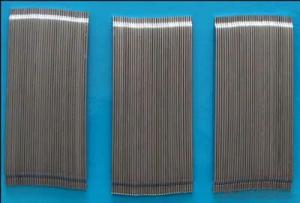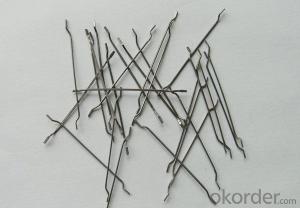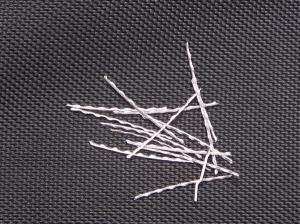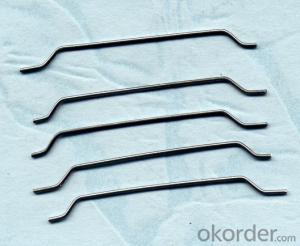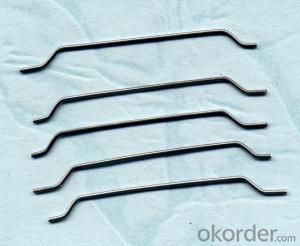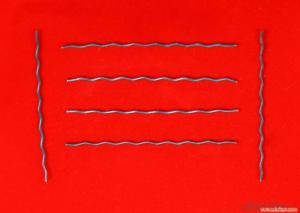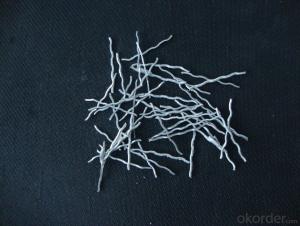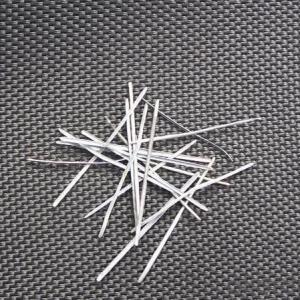Melt Extract Stainless Steel Fiber Reinforced Concrete Admixtures
- Loading Port:
- Tianjin
- Payment Terms:
- TT OR LC
- Min Order Qty:
- 1000 kg
- Supply Capability:
- 250000 kg/month
OKorder Service Pledge
OKorder Financial Service
You Might Also Like
Quick Details
Place of Origin: Shandong, China (Mainland)
Model Number: steel fiber
material: steel wire
application: concrete reinocement
type: end hook steel fiber
Product features
with excellent tensile ,hightenacity ,against cracking and fatigue ,they`re widely usd in the structures made of concrete
Specifications
1.hooked steel fiber
2.CE and ISO9001:2008
3.diameter from 0.5mm to 1.2mm
4.competitive price,high quality and service
Hooked Steel Fiber:
1.Diameter:0.5mm-1.0mm
2.Length: 25mm-60mm
3.Material: low carbon steel wire
4.Feature: excellent tensile,high tenacity,against cracking,impact and fatigue
5.Uses: high way,tunnel,building,airport road serface and so on .
Picture
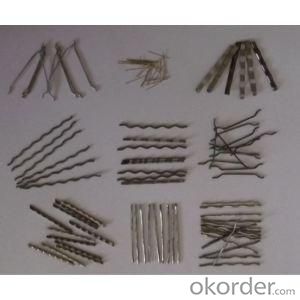
steel fiber concrete reinforced
1.hooked steel fiber
2.CE and ISO9001:2008
3.diameter from 0.5mm to 1.2mm
4.competitive price,high quality and service

FAQ
we can produce any type steel fiber and of course we can make production according to your requirement
we have specilize in this field for almost 10 years ,with good quality and competitive price
- Q: How does the addition of melt extract stainless steel fiber affect the permeability of concrete?
- The addition of melt extract stainless steel fiber tends to decrease the permeability of concrete.
- Q: Can melt extract stainless steel fiber be used in fiber-reinforced polymer (FRP) concrete mixtures?
- Yes, melt extract stainless steel fiber can be used in fiber-reinforced polymer (FRP) concrete mixtures. The addition of these fibers improves the overall strength, durability, and crack resistance of the FRP concrete.
- Q: Can melt extract stainless steel fiber be used in racetrack pavements?
- Indeed, racetrack pavements can benefit from the utilization of melt extract stainless steel fiber. It is common practice to incorporate stainless steel fibers into concrete as a means of fortifying its endurance and efficacy. The inclusion of stainless steel fibers within the pavement mixture is efficacious in averting cracks and augmenting resistance to deterioration, rendering it ideal for racetrack pavements that encounter heavy loads and swift vehicles. Furthermore, the stainless steel fibers exhibit exceptional resistance to corrosion, an essential attribute in open-air settings where racetracks are exposed to diverse weather conditions. All in all, the implementation of melt extract stainless steel fiber in racetrack pavements can heighten their longevity and performance, guaranteeing a secure and dependable surface for racetrack activities.
- Q: Can melt extract stainless steel fiber be used in retaining walls?
- Retaining walls can indeed utilize melt extract stainless steel fiber. In numerous construction scenarios, including retaining walls, stainless steel fiber serves as a prevalent reinforcement material. It boasts exceptional tensile strength, corrosion resistance, and durability, rendering it ideal for withstanding the pressures and forces confronting retaining walls. By incorporating stainless steel fiber into the concrete mixture, the overall structural integrity of the retaining wall can be enhanced, reducing the likelihood of cracking and enhancing its long-term performance. As a result, melt extract stainless steel fiber presents itself as a fitting choice for reinforcing retaining walls.
- Q: Does melt extract stainless steel fiber enhance the flexural toughness of concrete beams?
- Concrete beams experience an enhancement in flexural toughness when melt extract stainless steel fiber is utilized. The inclusion of these fibers in concrete mixtures leads to a significant improvement in the beams' ability to withstand bending and flexural forces. By incorporating stainless steel fibers, the material's tensile strength and ductility are increased, resulting in a strengthened resistance to cracking and an overall improvement in toughness. This reinforcement ensures that applied loads are evenly distributed, reducing the likelihood of brittle failure and enhancing the structural performance of the concrete beams. Furthermore, the small size and high aspect ratio of melt extract stainless steel fibers enable better dispersion and bonding within the concrete matrix, further heightening their effectiveness in enhancing flexural toughness.
- Q: Can melt extract stainless steel fiber be used in industrial flooring applications?
- Indeed, melt extract stainless steel fiber finds utility in the realm of industrial flooring applications. This particular fiber variety is renowned for its commendable robustness and endurance, attributes of utmost importance when it comes to flooring in industrial environments. Its capacity to endure substantial loads, impacts, and abrasions renders it apt for spaces that witness heavy pedestrian traffic or house machinery. Moreover, stainless steel fibers possess a resistance to corrosion and chemicals, guaranteeing a prolonged lifespan for the flooring material. Incorporating these fibers into concrete or alternative flooring substances is a simple task that elevates their potency and efficacy. All in all, melt extract stainless steel fiber emerges as a trustworthy option for industrial flooring applications.
- Q: Can melt extract stainless steel fiber be used in lightweight concrete blocks or panels?
- Melt extract stainless steel fiber is applicable for utilization in lightweight concrete blocks or panels. Lightweight concrete blocks or panels are commonly produced using lightweight aggregates and diminishing the density of the concrete mixture. The inclusion of stainless steel fibers can heighten the mechanical characteristics of the lightweight concrete, such as augmenting tensile and flexural strength, lessening cracking, and enhancing the overall durability of the blocks or panels. Stainless steel fibers possess high tensile strength, corrosion resistance, and exceptional bonding properties with concrete, making them ideal for reinforcing lightweight concrete structures. Moreover, the incorporation of stainless steel fibers can also furnish improved resistance to fire, impact, and fatigue. Consequently, melt extract stainless steel fiber serves as an appropriate choice for reinforcing lightweight concrete blocks or panels.
- Q: Can melt extract stainless steel fiber improve the resistance of concrete to fire?
- Yes, melt extract stainless steel fiber can improve the resistance of concrete to fire. Stainless steel fibers are known for their high melting point, corrosion resistance, and excellent heat conductivity, making them an ideal choice for enhancing the fire resistance of concrete. When added to concrete, these fibers create a three-dimensional reinforcement network that helps to prevent cracks and spalling during fire exposure. The stainless steel fibers also act as a heat sink, absorbing and dissipating heat more efficiently, which can significantly delay the temperature rise in the concrete, thus increasing its fire resistance. Additionally, the fibers enhance the overall strength and durability of the concrete, making it more resilient to fire and prolonging its structural integrity under high temperatures. Therefore, incorporating melt extract stainless steel fiber into concrete can indeed improve its resistance to fire.
- Q: Does melt extract stainless steel fiber improve the resistance to carbonation of concrete?
- Yes, melt extract stainless steel fiber can improve the resistance to carbonation of concrete. The addition of these fibers helps to enhance the durability and lifespan of concrete by reducing its permeability to carbon dioxide, which in turn minimizes the risk of carbonation and subsequent corrosion of the reinforcing steel.
- Q: Can melt extract stainless steel fiber be used in tunnel segments?
- Melt extract stainless steel fiber is indeed applicable for tunnel segments. It is a common practice to incorporate stainless steel fibers into concrete mixtures for the purpose of enhancing the material's mechanical properties and increasing its durability. By incorporating stainless steel fibers, the strength and crack resistance of concrete segments in tunnel construction can be significantly improved, thereby minimizing the likelihood of structural failures. Furthermore, stainless steel fibers offer superior resistance to corrosion, making them a suitable choice for tunnel segments that may face moisture or aggressive environments. Consequently, melt extract stainless steel fiber can be utilized effectively in tunnel segments to enhance their structural integrity and prolong their lifespan.
Send your message to us
Melt Extract Stainless Steel Fiber Reinforced Concrete Admixtures
- Loading Port:
- Tianjin
- Payment Terms:
- TT OR LC
- Min Order Qty:
- 1000 kg
- Supply Capability:
- 250000 kg/month
OKorder Service Pledge
OKorder Financial Service
Similar products
Hot products
Hot Searches
Related keywords
